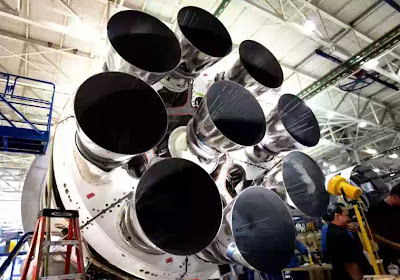SpaceX has produced the milestone 100th Merlin 1D rocket engine to powers its Falcon 9 launch vehicle. The significant milestone was achieve...
Falcon 9 first stage has nine Merlin 1Ds, that produce nearly 1.5 million pounds of thrust in vacuum. The 100th Merlin 1D is slated to fly on a Falcon 9 in early 2015.
The Merlin 1D is an all-American engine designed and built in-house at SpaceX’s headquarters in Hawthorne, California. Engines are currently manufactured at a rate of four per week, projected to rise to five per week by the end of 2014.
The production process begins with major engine components – injector, turbopump, gas generator, thrust chamber, valves and actuators – integrated with tubing, sensors, and other small components to form the major sub-assemblies of the engine.
These sub-assemblies are put together to become the engine’s lower and upper assembly. Once the lower and upper assemblies are stacked and mated, the engine undergoes a series of quality checks prior to testing.
Engines are tested at SpaceX’s state-of-the-art Rocket Development Facility spanning more than 4,000 acres in McGregor, Texas. Once the engine is verified to meet design requirements and perform reliably under flight conditions, it is shipped back to California, where it is flight configured and integrated into the Falcon 9 first stage’s octaweb engine structure.
The completed stage is then shipped back to Texas for a test firing of all nine engines at once, and then to the appropriate launch site for a final test as part of a full system prior to launch.With the highest thrust-to-weight ratio of any booster engine – 155:1 – each Merlin 1D engine can lift a weight equivalent to about 40 average cars.
Together, the first stage’s nine engines put out 1.3 million pounds of thrust at sea level, rising to 1.5 million as the first stage climbs out of Earth’s atmosphere. The nine engines burn about 540 gallons of propellant per second – enough to drain a typical home swimming pool in less than a minute.
To date, eighty Merlin 1Ds have launched, exceeding the propulsion heritage of the RS-68/68A engine (41 flown) on the Delta and the RD-180 engine (55 flown) on Atlas variants.
The Falcon 9's first stage has to burns for a duration of 185 seconds for a successful launch. The engine has the ability to throttle from 100 percent to 70 percent.
These sub-assemblies are put together to become the engine’s lower and upper assembly. Once the lower and upper assemblies are stacked and mated, the engine undergoes a series of quality checks prior to testing.
Engines are tested at SpaceX’s state-of-the-art Rocket Development Facility spanning more than 4,000 acres in McGregor, Texas. Once the engine is verified to meet design requirements and perform reliably under flight conditions, it is shipped back to California, where it is flight configured and integrated into the Falcon 9 first stage’s octaweb engine structure.
The completed stage is then shipped back to Texas for a test firing of all nine engines at once, and then to the appropriate launch site for a final test as part of a full system prior to launch.With the highest thrust-to-weight ratio of any booster engine – 155:1 – each Merlin 1D engine can lift a weight equivalent to about 40 average cars.
Together, the first stage’s nine engines put out 1.3 million pounds of thrust at sea level, rising to 1.5 million as the first stage climbs out of Earth’s atmosphere. The nine engines burn about 540 gallons of propellant per second – enough to drain a typical home swimming pool in less than a minute.
To date, eighty Merlin 1Ds have launched, exceeding the propulsion heritage of the RS-68/68A engine (41 flown) on the Delta and the RD-180 engine (55 flown) on Atlas variants.
The Falcon 9's first stage has to burns for a duration of 185 seconds for a successful launch. The engine has the ability to throttle from 100 percent to 70 percent.











